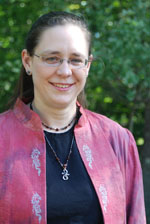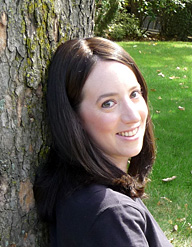The third installment in our discontinuous series of “blog tour” posts featuring fellow members of the Codex Writers online community.
Today our guest is Elaine Isaak, who dropped out of art school to found Curious Characters, designing original stuffed animals and small-scale sculptures, and to follow her bliss: writing. Elaine is the author of The Singer’s Crown (Eos, 2005), and sequels The Eunuch’s Heir (Eos, 2006) and The Bastard Queen (Swimming Kangaroo, 2010).

(The Bastard Queen cover art. Click to enlarge.)
Beloved bastard of an unloved king, Fiona will do anything to please her father, even studying magic though she never shows more than a spark of talent. But the plague that grips their city sends her to work with the dying, as enmity builds between the two peoples her father has brought together.
Struggling to find a cure for the plague, Fiona discovers that its emergence is no coincidence—and that her scorned suitor may be leading a conspiracy that will end in genocide. Even her father wears a false face, and every new tragedy reveals another secret set to shatter her life and her kingdom.
A mother of two, Elaine also enjoys rock climbing, taiko (Japanese drumming), weaving and exotic cooking — when she can scrape the time together.

(Elaine Isaak. Click to enlarge.)
Given all her many activities, we appreciate Elaine taking time out to answer our questions about how she turned her idea for The Bastard Queen into reality.
___
How long was it between first conceiving The Bastard Queen and actually working on it in earnest? What did you do in the interim?
This one had to wait. It’s the third in a generational series (that is, they build on each other, but they’re not a single story-arc). I had finished the first and second, but hadn’t sold them yet. While I had some fun ideas for a third, it seemed foolish to work more on something I wouldn’t be able to sell for a while. Instead, I had a dramatic idea for a different series which I started in the meantime, giving myself a second book to offer if my first series didn’t sell. Ultimately, it did, and I had the chance to write The Bastard Queen — it was definitely informed by some of the research I was doing for the new books.
How long did it take to complete The Bastard Queen? How did the work progress, from research to publication?
The research happened during the two year interval that it took to sell the first books, so I was able to write quickly once I hit the ground. I think it was about 9 months of writing and my revision. Publishing was another matter because of some difficulties with the original publisher, then a change of agent. I finally sold the book to a small press, but it took about another two years. They have a very professional approach to editing, and we worked on revision for another year, then production.
What major obstacle did you have to overcome while working on The Bastard Queen? How did you overcome it?
I changed publishers and agents, leaving this book sort of dangling in the breeze. After much consideration, focusing on my new series made more sense than trying to place this book with another big publisher. Naturally, that brought difficulties of its own, including a problem printing the covers that almost forced a delayed release (and would have ruined the promotional plan I had put in place).
Writing books, for me, is easy. The business of writing, not so much.
What was the biggest surprise you got out of working on The Bastard Queen, and what do you hope your readers get out of it?
This was the first time I had written a full-length novel with a female protagonist. For me, it was a process of overcoming my own perception that, well, boys have more fun. Especially after the more adventure-based The Eunuch’s Heir, it took me a little while to really inhabit Fiona and her concerns.
In general, I want to create worlds and societies that have more realistic complications than are often associated with fantasy fiction. I like to work in the ambiguous spaces where good guys might do bad things.
What’s your next project … and what did you learn from The Bastard Queen that you’re applying to it?
Interestingly, it’s sort of the other way around. The dark historical fantasy series I’ve recently sold is the one I started when I set aside The Bastard Queen. As a result, my “new” work actually informed this older one rather than the other way around. But I think exploring some of the issues of class and race that crop up in The Bastard Queen, and trying to achieve a stronger level of realism, will serve me well as I move ahead with the new books.
___
We’re glad we had this opportunity to showcase Elaine Isaak and her new book The Bastard Queen. And don’t forget about the two books ahead of it in the series:


(Cover art for The Singer’s Crown and The Eunuch’s Heir. Click to enlarge.)
Visit www.ElaineIsaak.com to read sample chapters of The Bastard Queen and find out why you do NOT want to be her hero.











